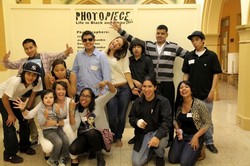“I wasn’t working with the youth, but I noticed that as I was taking pictures at my church, kids were fascinated with my camera,” said photographer Leanna Creel, remembering the beginnings of Photopiece, which has become a program that helps teenagers share their stories with the world.
After observing the youth’s interest in photography, Creel approached Mike and Sandi Drinkward-Herrmann, fellow members of Immanuel Presbyterian Church and teachers at an urban school in Los Angeles, and asked them if they could round up some kids who would like to take a photography class that she proposed to host at the church.
“At the beginning I had no idea what I was doing — I had never been a youth leader before,” Creel said. “I just had a passion for photography and thought it might be a way to connect with the youth.”
More than a decade later, Creel is now teaching younger siblings, cousins and friends of those first Photopiece students — a legacy that can often elude more traditional church youth groups.
“It was, in many respects, just an excuse to get kids together — we didn’t have a strong history of youth ministry at our church,” Creel said.
The first class was made up of students at Belmont High School who were failing and in danger of being kicked out. Each student was given a Holga camera — plastic, lightweight and fairly inexpensive — with which to take pictures. Each week they were given a roll of film and an assignment: to photograph something that made them ‘mad, sad or glad’ or to look for patterns, repetition or other design elements that caught their attention.
“Every week as we got together and looked over their photos from the previous week, I would ask them about their pictures, and what they were about, what they meant,” said Creel.
It was from such discussions that the name Photopiece came into being.
“Through talking about their pictures I began to see that many had to do with graffiti or tagging,” said Creel. “I would ask them about it.”
Through those conversations about their photos, Creel learned about graffiti culture. “They’d tell me, ‘Oh that? That’s just a quick piece’ or ‘We’re just going piecin,’’ and it was from that term that we got the name,” said Creel. Piecin’, as Creel came to find out, was short for ‘masterpiece’ and the phrase the youth would use to refer to their graffiti art. “So, instead of going piecing, they began to go ‘photo piecing,’” said Creel.
“It really became an attempt to help these kids express themselves through art — kids who were not succeeding in school or at home, but still had a lot to say,” Creel said. “How can we help them find a way to speak, to share and to participate and to help give kids a positive label for themselves?”
At the end of that first course, each student, with Creel’s input, selected their favorite photos to be presented as part of an exhibit.
“It was at the exhibit, where we literally gave them a label — a nametag on which it said ‘photographer’ — that I realized for many of these kids it was the first time in their lives they had been given a positive label,” said Creel. “For the first time, people were listening to them, seeing them and recognizing them — in this case for being a photographer.
“Many of the students started out extremely shy — it was almost painful for them, the idea of showing people — adults — their pictures, and thinking that people were not going to like them,” said Creel. “But then, instead, having people see their work and tell them how good it was, that was incredibly powerful.”
Arturo was one such shy student from those early classes. He rarely said more than three or four unless Creel asked him to describe his photos.
“I remember after the class when Arturo’s dad came up to me and said, with tears in his eyes, ‘You have given my son something that has given him a reason to go to school’. They were afraid he’d get caught up in the graffiti culture and that would get him into trouble,” said Creel.
Not only did Arturo stay in school, but he became the photographer for his high school, is now attending college and has become a teacher of Photopiece and a photographer in his own right.
“Photopiece gave him something positive, that he was good at, and gave him the confidence to complete it,” Creel said.
Creel herself is a self-taught photographer who has never taken a photography class in a school or educational setting. “The irony is that it gave me confidence in my own photography,” she said.
For more information about Photopiece contact Leanna Creel at leanna@creelfilms.com or find them on Facebook.
Erin Dunigan is a freelance writer, photographer, and pastor who lives in a small coastal community in Baja California, Mexico when she is not following her wanderlust out into the world.

